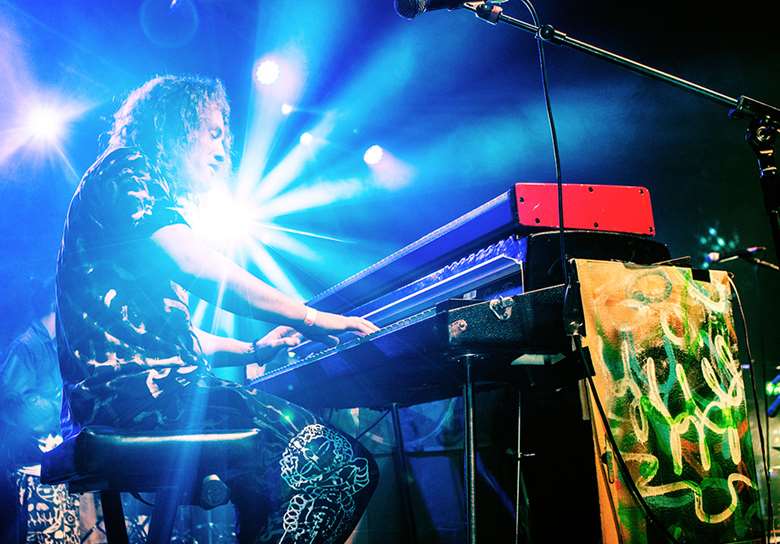Joe Armon-Jones’ depth-charge dub-jazz delights at Electric Brixton
Christine Hannigan
Monday, February 10, 2020
The keyboardist leads a talent-packed band at this bass-heavy south-London night

Joe Armon-Jones headlined Electric Brixton for the London leg of his European tour, but the evening was far from a canned, travel-ready show. It showcased local talent and gave its due to the Jamaican-rooted traditions, notably dub, that permeate his music. Sound system collective Unit 137’s twin pyramids of 16 hand-built, high-fidelity speakers of varying size was a visual testament and powered the duration of the evening. Before his headlining band went on, most of them danced in front of the ground-level DJ booth opposite the stage helmed by members of Unit 137, including Phoebs, Hylu, Sleepy Time Ghost, and Ed West, with vocal performances from Shumba Youth, with backup from Dalousie (flute) and Lukey Boy P (trombone).
Between two of Unit 137's performances, Turn to Clear View's producer Maxwell Owin DJ'd, offering a taste of the many elements that make the album. Over bass deep enough to blur your vision, he sampled jazz icons alongside dub and featuring the rap of Luke Newman. Deemas J’s rapid-fire MC’ing and dancehall icon Daddy Freddy’s ragga left the crowd fully energised. They turned around to find Asheber (vocals), Nubya Garcia (tenor sax), Kwake Bass (drums), Mutale Chashi (bass), Oscar Jerome (guitar), James Mollison (tenor sax), Ife Ogunjobi (trumpet), and Armon-Jones ready to go on the stage amid panels and large hanging canvases by Rago Foot, the centre of which was painted as a darker response to Turn to Clear View’s celestial-themed album cover by Divya Scialo. Art by Ryan Hawaii (otherworldly figures with heads dominated by a single eye) and Mr. Trap Art (ludicrously grinning daisies with X’d out eyes) decorated the venue above doorways and balconies.
Decked out in coordinated, skull-patterned outfits also of Rago Foot’s design, the band played the entirety of Turn to Clear View, which limited the expansive solos that one may have expected given the line-up’s talent. However, anyone who came to hear Armon-Jones’s funky, harmonically masterful improvisations would not have been disappointed. Under his lead and over Kwake Bass’s deft rhythmic and electronic transitions, the band grooved into full synchronicity through jazz, reggae, and hip hop.

Garcia (posters for her own Electric Brixton show in June were hung on the pillars) soared with lyricism in ‘Yellow Dandelion’ and wailed in ‘You Didn't Care’. Ogunjobi’s bebop solo on ‘Gnawa Sweet’ was perhaps the most quintessentially “jazz” of the night, and Mollison and Jerome each shone in their respective jams on ‘To Know Where You Are Coming From’. The horns weren’t the only ones singing: Rapper Jehst joined the band for ‘The Leo and Aquarius,’ a romantic hip hop song to a new mother. Asheber’s rich, versatile voice bookended the show. The opener of Turn…, ‘Try Walk With Me’ is an elegiac jazz song seeking peace in the landscapes of Africa. The closing reggae jam, a yet-to-be-released call to action to deliver justice to the victims of the Grenfell Tower fire, had a rousing beat but the gravity of the song’s subject matter seemed lost on the audience.
In January at a CDR artist talk at Five Miles, Armon-Jones told Tony Nwachukwu his childhood forays into jazz and improvisation were solitary pursuits at home, where his parents exposed him to influences like Chick Corea and Keith Emerson. Moving to London for school taught him how to play in groups – he no longer had to provide the bassline himself – and got him playing around town, including a recurring gig at a Greenwich comedy club where the owners didn’t care what the group did and where the audience only cared about getting drunk, which gave the developing musicians freedom to play and practice what they liked.
Armon-Jones openly and graciously credits his collaborators and influences. Of the long list of names on the show poster, his wasn’t even in the largest font. The album art of his second-to-last album Starting Today, drawn by Divya Scialo, grants the listener a glimpse into his creative surroundings and influences. A comfy-looking living room floating through space is decorated with, among other artefacts, Nubya Garcia’s album (whom he credited with inspiring him to book a studio), and a bust of Maxwell Owin. Armon-Jones makes music at home with Owin and in the nearby studio of Kwake Bass. In front of a crowd of around 1,000, the band still gave off the vibe of a group of friends having a great time jamming together.